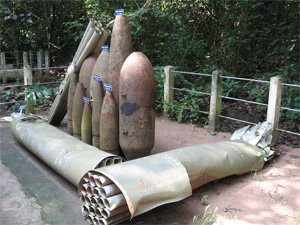Semester at
Sea Fall
2006 Voyage 
- Home Page
- My bio
- Transnational Ethnography: Issues of Vernacular Preservation: Migrants in Hong Kong and Spain
- Japan: Vernacular Atmosphere
- Hong Kong: A Family Abroad
- Vietnam:
The Numbing Effects of War Tourism
- Burma:Doctored Perceptions of
Rangoon
- India: A Source of Contrasts
- Spain: Spain's Identity Crisis
- Open Letter
The
Numbing Effects
of War Tourism
Jessica Von Wendel
I grew up near an army base, so I
always knew the sounds of guns and artillery, but the sounds I heard
while
visiting the Chu Chi tunnels in  arrived
at this war site, I viewed a black and white
documentary
depicting the heroism of the guerilla fighters and the pride they took
in
killing American soldiers. This film could
be described as Communist propaganda and was not softened for
potentially
sensitive American visitors. As the
anthropologist Christina Schwenkel describes, “a mural depicting scenes of bloodied
U.S.
soldiers caught in the clenches of bamboo traps or falling onto
piercing stakes
demonstrates the efficacy of the rudimentary yet inventive defense
system and
signifies a celebratory form of Vietnamese historical memory: the
defeat of the
United States.” This is how the
Vietnamese experienced and view the war, and there isn’t anything
inherently
deceptive about it: what is intriguing is how this site is
experienced by
Americans.
arrived
at this war site, I viewed a black and white
documentary
depicting the heroism of the guerilla fighters and the pride they took
in
killing American soldiers. This film could
be described as Communist propaganda and was not softened for
potentially
sensitive American visitors. As the
anthropologist Christina Schwenkel describes, “a mural depicting scenes of bloodied
U.S.
soldiers caught in the clenches of bamboo traps or falling onto
piercing stakes
demonstrates the efficacy of the rudimentary yet inventive defense
system and
signifies a celebratory form of Vietnamese historical memory: the
defeat of the
United States.” This is how the
Vietnamese experienced and view the war, and there isn’t anything
inherently
deceptive about it: what is intriguing is how this site is
experienced by
Americans.
Before I knew what I was doing I was
getting my picture taken on an American tank that had been destroyed by
a
Vietnamese mine. Everyone was smiling
and having their friend photograph them. The
minute I stepped down I felt a wave of guilt and
disgust that
overpowered me and lasted for the rest of the tour.
Somehow the Vietnamese have been able to
transform an area of brutal devastation into an amusement park. Americans were smiling and laughing on ground
where numerous people were killed.
As we
walked farther we reached the
firing grounds where for $1.60 a bullet you can fire an AK-47. I had originally planned on doing this
despite being a pacifist. I kept
thinking:
when else in my life would I have such an opportunity?
As we came out of the wooded area and into
the range I heard the shots: incredibly loud single blasts with an
occasional
piercing rapid fire. My heart stopped
and I couldn’t walk any further. Everyone
else went up to buy bullets or look at the war
souvenirs for
sale. I looked at my friend and she
asked if I felt strange and we agreed the energy of the place was all
wrong. She actually started crying and
so we left the group and went back into the jungle where the sounds of
the guns
were muffled.
The Vietnamese government designed
these war sites for tourists, but the Vietnam War was only thirty five
years
ago. The generation that experienced it
first hand is still alive. This was not
some battle that happened hundreds of years ago. Yet
our guide was able to lead American students through
stations that
depict the brutality of war against soldiers of our parents' generation
without
evoking much emotion. Through the
amusement attraction design of the tour, Americans were compelled to
have their
picture taken on a destroyed
course home page